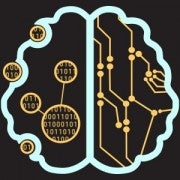Scientific American – Anthony Zador, Yann LeCun, September 26, 2019
Don’t Fear the Terminator
Artificial intelligence never needed to evolve, so it didn’t develop the survival instinct that leads to the impulse to dominate others.
As we teeter on the brink of another technological revolution—the artificial intelligence revolution—worry is growing that it might be our last. The fear is that the intelligence of machines will soon match or even exceed that of humans. They could turn against us and replace us as the dominant “life” form on earth. Our creations would become our overlords—or perhaps wipe us out altogether. Such dramatic scenarios, exciting though they might be to imagine, reflect a misunderstanding of AI….read more
Brain Inspired Interview – Podcast by Paul Middlebrooks, May 8, 2019
BI 034 Tony Zador: How DNA and Evolution Can Inform AI
Use the media player above or follow this link to the Brain Inspired page to listen to the interview.
Click here to read the full transcript of the podcast.
Medical Xpress, May 28, 2018
Revolutionary brain-mapping technique provides new blueprint for cortical connections
Using a revolutionary new brain-mapping technology recently developed at Cold Spring Harbor Laboratory (CSHL), an international team of scientists led by Professor Anthony Zador have made a discovery that will force neuroscientists to rethink how areas of the cortex communicate with one another.
The new technology, called MAPseq, allowed the scientists to determine that neurons in the primary visual cortex communicate with higher visual areas of the cortex much more broadly than previously believed, and according to specific patterns… read more
Quanta Magazine, April 4, 2018
New Brain Maps With Unmatched Detail May Change Neuroscience
Sitting at the desk in his lower-campus office at Cold Spring Harbor Laboratory, the neuroscientist Tony Zador turned his computer monitor toward me to show off a complicated matrix-style graph. Imagine something that looks like a spreadsheet but instead of numbers it’s filled with colors of varying hues and gradations. Casually, he said: “When I tell people I figured out the connectivity of tens of thousands of neurons and show them this, they just go ‘huh?’ But when I show this to people …” He clicked a button onscreen and a transparent 3-D model of the brain popped up, spinning on its axis, filled with nodes and lines too numerous to count. “They go ‘What the _____!’”… read more
Drug Target Review, April 3, 2018
MAPseq technique provides new blueprint for cortical connections
Using a revolutionary new brain-mapping technology an international team of scientists have made a discovery that will force neuroscientists to rethink how areas of the cortex communicate with one another.
The new technology, called MAPseq, allowed the scientists to determine that neurons in the primary visual cortex communicate with higher visual areas of the cortex much more broadly than previously believed, and according to specific patterns… read more
Spiegel Online, January 18, 2018
Der Mann, der Gedanken lesen kann
Bescheidenheit ist Anthony Zadors Sache nicht, und so hat er sich nie mit Kleinem begnügt. Stets wagte er das Große. Schon als Doktorand nahm sich der Neurowissenschaftler vor, eine Maschine mit Bewusstsein zu erschaffen. Zwar musste er einsehen, dass dies dann doch schwieriger war als gedacht. Aber seine visionäre Tatkraft blieb ungebremst… Weiterlesen
Observer, May 19, 2017
Government’s ‘Golden Fleece’ Is Now Humanity’s Golden Goose
William Proxmire of Wisconsin retired from Congress almost 30 years ago, but he would fit right in as a senator today. An avowed opponent of government waste, he famously created the “Golden Fleece Award” to draw attention to whatever he deemed to be frivolous Federal spending. Some of the awards still hold as much crowd appeal as they did back then—the fourth award, in 1975, went to the U.S. Congress for “living high off the hog while much of the rest of the country is suffering economic disaster.” But many of his awards went to the National Science Foundation, NASA, and scientific agencies, targeting what he saw as pointless scientific research. These misguided awards reflect a widespread but wrongheaded understanding of how scientific progress and breakthroughs are made… read more
MIT Technology Review, August 18, 2016
New Brain-Mapping Technique Captures Every Connection Between Neurons
The human brain is among the universe’s greatest remaining uncharted territories. And as with any mysterious land, the secret to understanding it begins with a good map.
Neuroscientists have now taken a huge step toward the goal of mapping the connections between neurons in the brain using bits of genetic material to bar-code each individual brain cell. The technique, called MAP-seq, could help researchers study disorders like autism and schizophrenia in unprecedented detail… read more
Foreign Policy, December 1, 2015
Foreign Policy 2015 Global Thinkers: Innovators
This year scientists made significant discoveries about the least understood part of the body: the brain. Three labs, in particular, began to unlock the organ’s extraordinary potential...read more
The Atlantic, October 15th, 2014
Rats Aren’t Smarter Than Mice and That Actually Matters
New research shows that when it comes to most psychology experiments, all rodents might be created equal...read more
Scientific American, June 24, 2014
Brainomics: Hacking the Brain (and Autism) with Gene Machines
Tony Zador is a professor of biology at the Cold Spring Harbor Laboratory who studies auditory processing, attention and decision-making in rodents. He spoke recently at the laboratory’s 79th annual symposium on quantitative biology, which focused this year on the topic of cognition. Zador talked about his recent work trying to demonstrate how brain circuits might be mapped by using techniques for sequencing genes. I met Zador at the conference and an edited transcript follows… read more
MIT Technology Review, October 25, 2012
DNA Sequencing Could Map the Brain’s Wiring
A fast, cheap way to identify neuron-to-neuron connections could shed light on disorders including autism and schizophrenia.
Many brain disorders, such as autism and schizophrenia, are likely caused by abnormal connections in the brain. Better understanding of these abnormalities could provide clues to ways to treat these problems… read more










